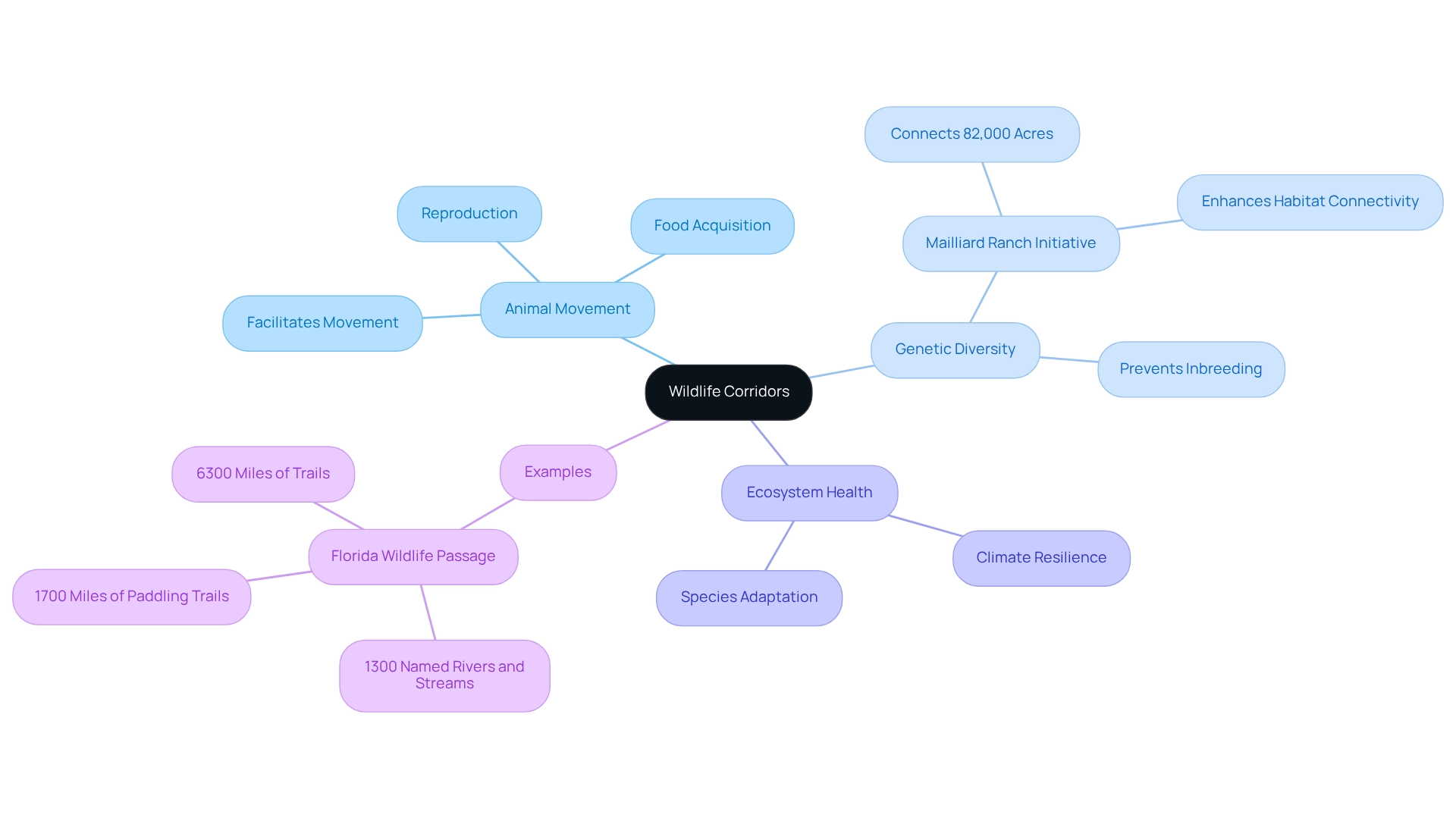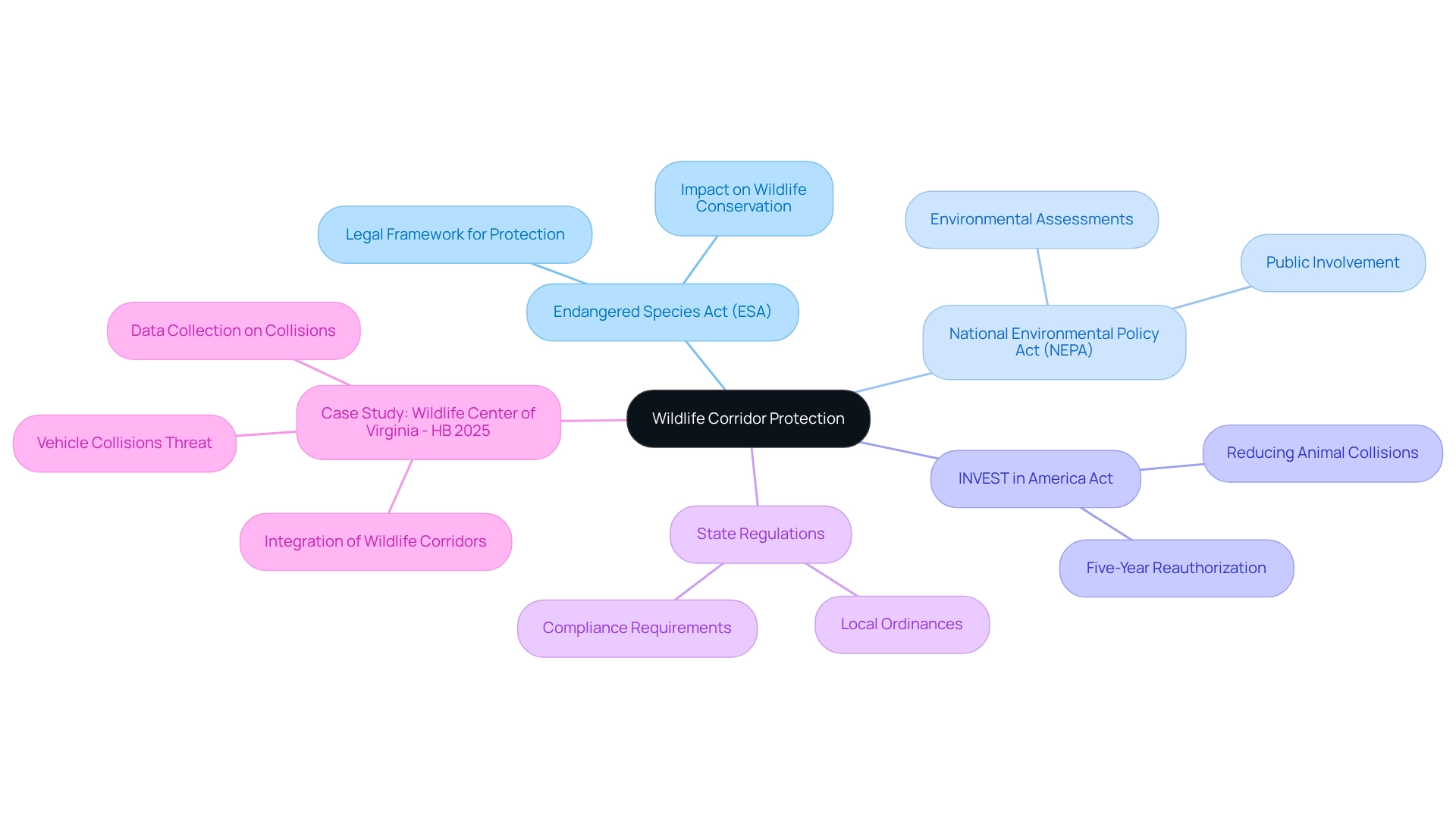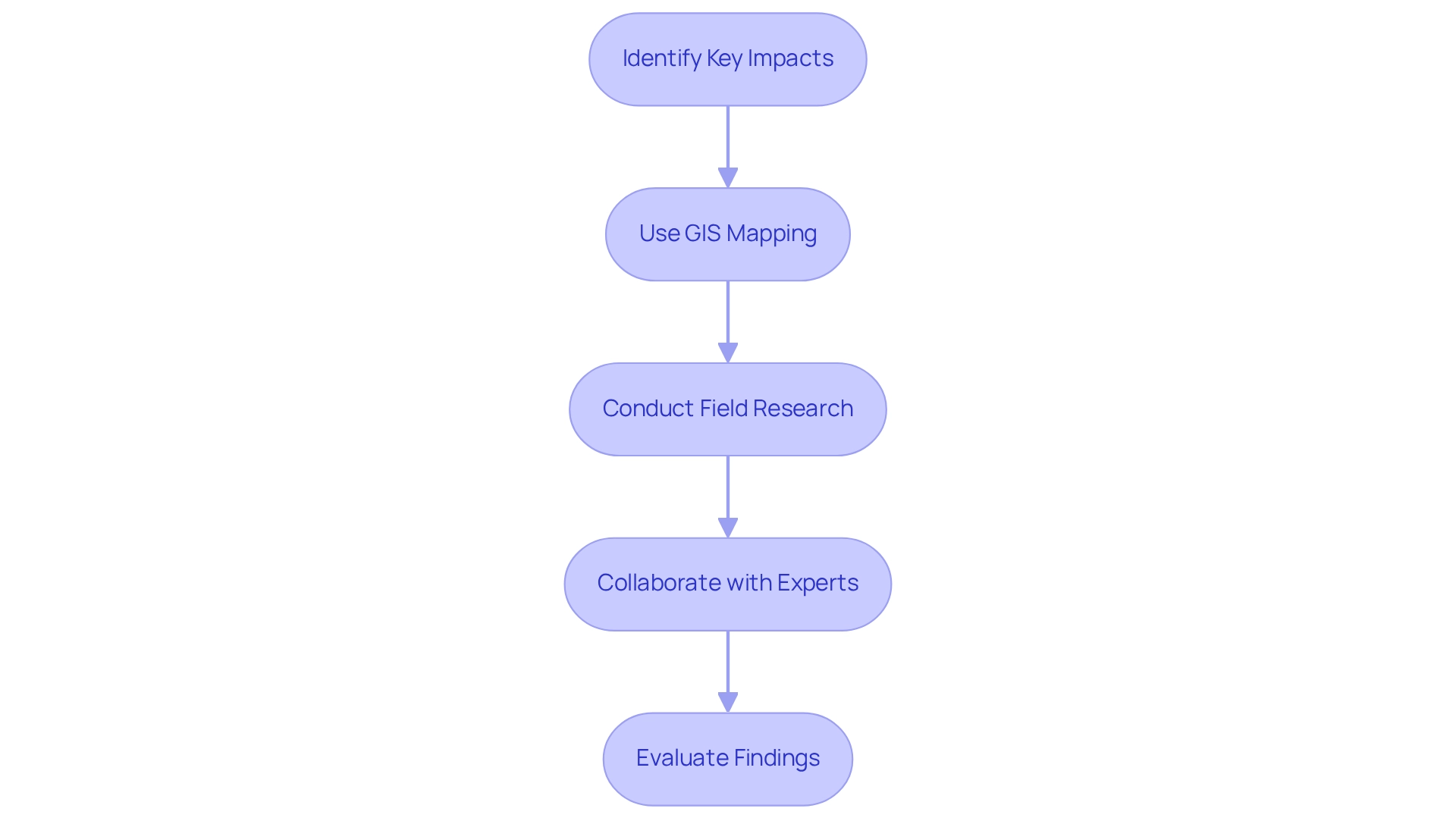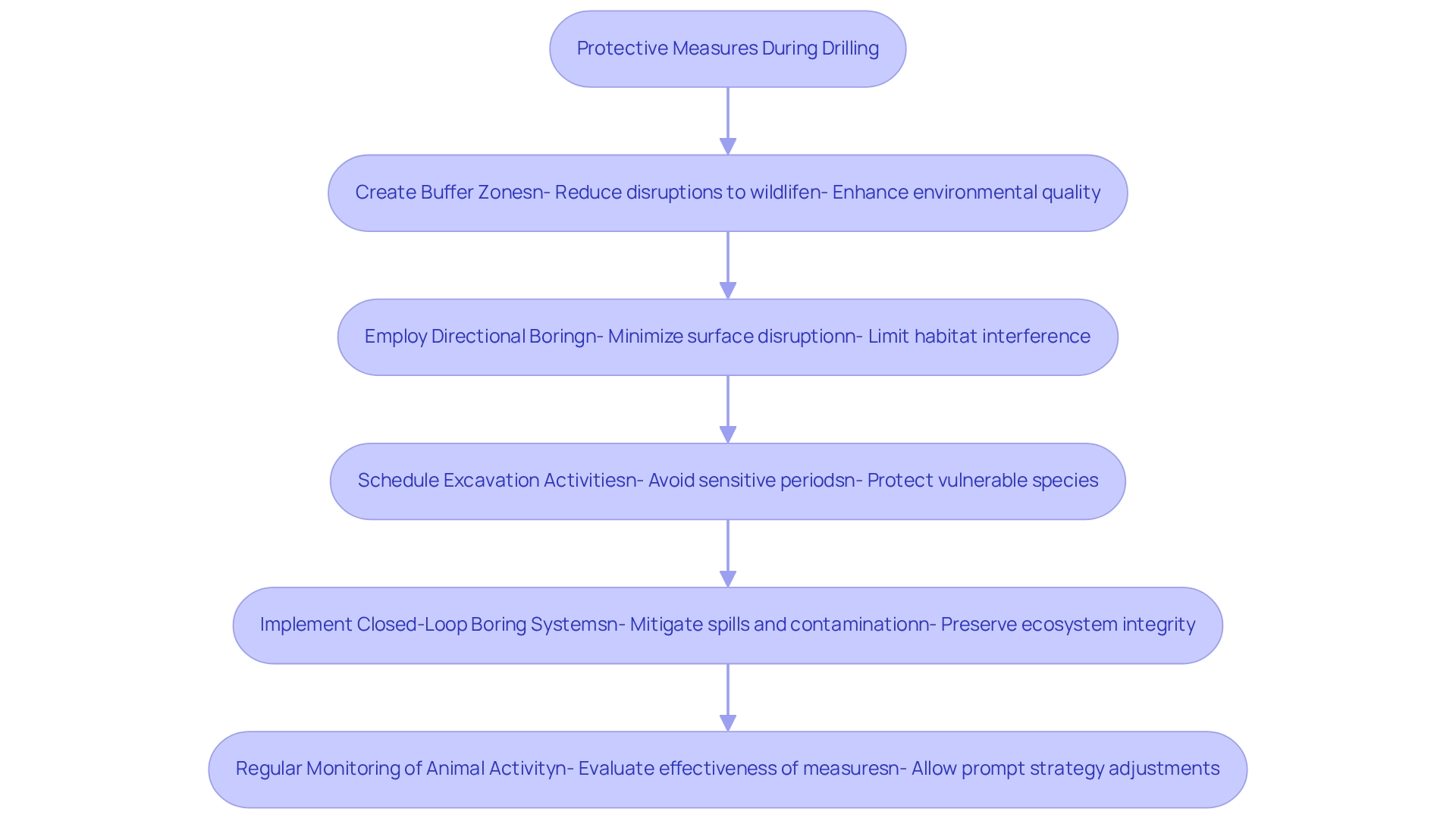Overview
The article delineates five crucial steps for safeguarding wildlife corridors amidst drilling operations, underscoring the necessity of:
- Strategic planning
- Legal compliance
- Stakeholder engagement
- Robust monitoring
It illustrates how these measures can effectively mitigate the adverse effects of drilling on ecosystems. For instance, establishing buffer zones and employing advanced technologies can significantly reduce habitat disruption, thereby ensuring the preservation of vital animal pathways.
Introduction
In the intricate dance between energy development and environmental conservation, wildlife corridors emerge as critical lifelines for countless species. These vital pathways not only facilitate animal migration and reproduction but also play an essential role in maintaining genetic diversity and ecosystem health. As the pressures of drilling and infrastructure expansion mount, understanding the significance of these corridors becomes paramount.
This article delves into the multifaceted relationship between wildlife corridors and drilling operations, exploring:
- Legal protections
- Potential impacts
- Stakeholder engagement
- Proactive measures that can safeguard these essential habitats for future generations.
With insights from experts and case studies, it highlights the urgent need for a balanced approach that prioritizes both ecological integrity and energy needs.
Understand the Importance of Wildlife Corridors
Wildlife passages serve as crucial conduits that connect fragmented habitats, facilitating animal movement, food acquisition, and reproduction. These corridors play a vital role in maintaining genetic diversity, which is essential for the survival of various species. A prime example is the Mailliard Ranch initiative, linking over 82,000 acres of protected land, demonstrating how strategic planning can enhance habitat connectivity, thereby bolstering genetic diversity and supporting wildlife populations.
As Kristen Shive, Director of Science, points out, "the importance of connectivity in our conservation planning is based on the idea that you need source populations from old-growth forests to repopulate second-growth stands that have been degraded." This statement highlights the critical role of animal pathways in preserving genetic variation and promoting ecosystem health.
The significance of animal passageways extends beyond individual species; they are integral to the overall health of ecosystems. By facilitating species adaptation to changing environments, these pathways bolster climate resilience. Additionally, they reduce the risks of inbreeding among isolated populations, which is essential for sustaining robust ecosystems. The Florida Wildlife Passage, featuring extensive trails and waterways, exemplifies the broader importance of such corridors across various ecosystems, enhancing connectivity and supporting diverse species.
As stakeholders in extraction projects recognize these benefits, implementing wildlife corridor protection during drilling becomes imperative to ensure the integrity of natural pathways. A comprehensive understanding of historical context is essential for shaping a sustainable future. By linking past experiences to current conservation efforts, we can cultivate a sustainable balance between energy development and environmental stewardship.

Identify Legal Protections for Wildlife Corridors
Before embarking on potentially tedious activities, it is crucial to acknowledge the legal safeguards related to wildlife corridor protection during drilling. Key federal laws, such as the Endangered Species Act (ESA) and the National Environmental Policy Act (NEPA), establish vital frameworks for wildlife corridor protection during drilling in these essential areas. The recent INVEST in America Act, which includes a five-year reauthorization of the surface transportation bill, highlights the importance of wildlife corridor protection during drilling, reflecting the legislative landscape that impacts animal passageways. Senator Linda Greenstein has noted that this bill will significantly reduce the frequency of animal collisions, emphasizing the importance of wildlife corridor protection during drilling as part of nature passage safeguards in relation to extraction activities. Furthermore, state-specific regulations and local ordinances may impose additional restrictions on land use that directly affect drilling activities. For instance, the Wildlife Center of Virginia's case study on HB 2025 illustrates the necessity of integrating animal pathways into infrastructure planning, emphasizing wildlife corridor protection during drilling to enhance safety for both wildlife and motorists.
To navigate these complexities effectively, stakeholders can utilize Harbinger Land's advanced title research solutions, which encompass negotiating and acquiring leases and easements, along with our expertise in site and right-of-way acquisitions. Our team employs highly integrated GIS modeling services to facilitate efficient easements, ensuring compliance with wildlife corridor protection during drilling and animal migration protections while optimizing time and cost efficiency. Conducting thorough research to fully understand these regulations, coupled with collaboration with legal experts or environmental consultants, can provide valuable insights into the specific protections applicable to the project area. This approach not only enhances the project's alignment with conservation efforts but also ensures that wildlife corridor protection during drilling is adhered to in order to meet legal requirements.

Assess Drilling Impact on Wildlife Corridors
To effectively ensure wildlife corridor protection during drilling activities, a comprehensive assessment of potential impacts is imperative. This evaluation must address:
- Ecosystem fragmentation
- Noise pollution
- The risk of [chemical spills
Geographic Information Systems (GIS) serve as crucial tools for mapping vital ecosystems, facilitating the identification of areas that may be impacted by extraction activities. For instance, GIS mapping can illustrate how extraction sites intersect with animal pathways, providing a visual representation of potential threats to wildlife movement and ecological stability.
Field research is equally vital; monitoring animal movement trends before and after extraction delivers valuable insights into the actual consequences of these activities. Collaborating with ecologists and wildlife biologists enriches the assessment process, ensuring that all potential risks are thoroughly evaluated. Expert analyses indicate that habitat fragmentation resulting from extraction can lead to decreased biodiversity and altered species behaviors, underscoring the urgent need for proactive measures.
In Ohio, where cropland averaged USD 307 per hectare, the economic ramifications of land use changes are significant. The Department of the Interior has articulated its intention to 'finalize protections of the whole U.S. Arctic Ocean from any future oil and gas leasing' by withdrawing 2.8 million acres of the Beaufort Sea from development, highlighting the importance of conservation strategies in extraction activities. Moreover, regulatory frameworks have struggled to keep pace with advancements in fracking technology, creating challenges in reconciling energy production with environmental stewardship.
Case studies, such as the Theodore Roosevelt Conservation Partnership's perspective on the Willow Decision, exemplify the intricacies of balancing energy production with environmental conservation. Their insights emphasize the necessity of enforcing robust preservation measures alongside extraction activities to ensure wildlife corridor protection during drilling. By harnessing advanced GIS tools and expert knowledge, stakeholders can make informed decisions that prioritize both energy requirements and ecological integrity.

Engage Stakeholders in Corridor Protection Efforts
Involving stakeholders—local communities, environmental groups, and government bodies—is crucial for ensuring wildlife corridor protection during drilling activities. Workshops and community gatherings not only raise awareness about the significance of these corridors but also collect valuable feedback regarding potential extraction effects.
Forming partnerships with conservation groups enhances the implementation of protective measures by leveraging their resources and expertise. Furthermore, clear communication about the excavation project and its potential impacts fosters trust and collaboration among all parties involved.
Yearly assessments of conservation strategies ensure that this cooperative approach aligns with conservation objectives while addressing community concerns, ultimately leading to more sustainable extraction practices.
As Biju Karakkonam, a nature and animal photographer, asserts, "I believe that photography can be a powerful tool for raising awareness about the importance of conservation," underscoring the vital role of effective communication in stakeholder engagement.

Implement Protective Measures During Drilling
To effectively achieve wildlife corridor protection during drilling operations, a multifaceted approach is essential. Creating buffer zones around vital ecosystems is fundamental, as these areas significantly reduce disruptions to wildlife. Research indicates that buffer zones can enhance environmental quality, with studies demonstrating that wetlands featuring continuous open water and simple vegetation structures support higher occurrences of waterbirds. Monitoring data gathered between 2019 and 2022 revealed that a reduction in woodland coverage led to a sharp decline in waterbird populations, underscoring the importance of preserving environmental quality.
As noted by Blackwell et al., "These findings emphasize that wetlands with ongoing open water presence and uncomplicated vegetation composition can increase waterbird occurrences, in line with earlier research on waterbird environment preferences." This authoritative insight reinforces the case for establishing buffer zones to protect these critical ecosystems.
Moreover, employing directional boring techniques minimizes surface disruption, facilitating more precise operations that limit habitat interference. Scheduling excavation activities to avoid sensitive periods, such as breeding seasons, is another crucial measure. This timing consideration safeguards vulnerable species during their most critical life stages. Additionally, the implementation of closed-loop boring systems mitigates the risk of spills and contamination, thereby preserving the integrity of surrounding ecosystems.
Regular monitoring of animal activity during drilling is vital for evaluating the effectiveness of wildlife corridor protection during drilling. This continuous assessment allows for prompt adjustments to strategies, ensuring that wildlife corridor protection during drilling remains both functional and secure. The involvement of the Native Village of Venetie Tribal Government in legal proceedings highlights the cultural significance of safeguarding animals and the collective responsibility to protect the environment.
By proactively adopting these strategies, stakeholders can significantly diminish the adverse impacts of drilling on animal habitats, fostering a more sustainable approach to energy and infrastructure development. As the conservation community prepares to respond to proposed regulations aimed at protecting wildlife, it is crucial to remain vigilant and committed to these protective measures.

Conclusion
Wildlife corridors are essential for balancing energy development and environmental conservation. These pathways facilitate animal migration, reproduction, and genetic diversity, as demonstrated by projects like Mailliard Ranch, which enhance habitat connectivity.
Legal protections such as the Endangered Species Act and the National Environmental Policy Act are crucial in safeguarding these corridors from drilling impacts. By understanding these frameworks, stakeholders can align their operations with conservation efforts. Assessing drilling impacts through tools like GIS is vital for identifying potential threats and implementing proactive measures.
Engaging local communities, environmental organizations, and government agencies is key to effective corridor protection. Collaborative efforts raise awareness of the significance of these corridors, leading to protective measures that prioritize ecological integrity alongside energy needs. Strategies such as establishing buffer zones, employing directional drilling techniques, and timing operations to avoid sensitive periods can significantly mitigate drilling impacts.
The challenge lies in harmonizing energy development with the preservation of wildlife habitats. Protecting these corridors is not merely an environmental obligation; it is a commitment to future generations and the biodiversity that sustains our planet. By prioritizing wildlife corridor protection, stakeholders can contribute to a sustainable future where ecological health and energy needs coexist.
Frequently Asked Questions
What are wildlife passages and why are they important?
Wildlife passages are corridors that connect fragmented habitats, allowing animals to move, find food, and reproduce. They are crucial for maintaining genetic diversity, which is essential for the survival of various species.
Can you provide an example of a successful wildlife passage initiative?
The Mailliard Ranch initiative is a prime example, linking over 82,000 acres of protected land. This demonstrates how strategic planning can enhance habitat connectivity, supporting genetic diversity and wildlife populations.
How do wildlife passages contribute to ecosystem health?
Wildlife passages facilitate species adaptation to changing environments, promote genetic variation, reduce inbreeding risks among isolated populations, and bolster climate resilience, all of which are integral to the overall health of ecosystems.
What is the significance of the Florida Wildlife Passage?
The Florida Wildlife Passage features extensive trails and waterways that enhance connectivity and support diverse species, exemplifying the broader importance of wildlife corridors across various ecosystems.
What legal frameworks protect wildlife corridors during drilling activities?
Key federal laws such as the Endangered Species Act (ESA) and the National Environmental Policy Act (NEPA) establish protections for wildlife corridors during drilling. The INVEST in America Act also highlights the importance of these protections.
How does wildlife corridor protection during drilling impact animal collisions?
According to Senator Linda Greenstein, the implementation of wildlife corridor protection during drilling will significantly reduce the frequency of animal collisions, thereby enhancing safety for both wildlife and motorists.
What resources can stakeholders utilize to ensure compliance with wildlife corridor protection?
Stakeholders can utilize Harbinger Land's advanced title research solutions for negotiating leases and easements, and their GIS modeling services to ensure compliance with wildlife corridor protection during drilling while optimizing efficiency.
What approach should stakeholders take to navigate wildlife corridor regulations effectively?
Stakeholders should conduct thorough research to understand applicable regulations and collaborate with legal experts or environmental consultants to ensure adherence to wildlife corridor protection during drilling and alignment with conservation efforts.
List of Sources
- Understand the Importance of Wildlife Corridors
- New Study Shows Habitat Corridors Increase Biodiversity | Save the Redwoods League (https://savetheredwoods.org/blog/new-study-shows-habitat-corridors-increase-biodiversity)
- Powerful quotes about nature and wildlife to inspire - Wildlife in the Balance (https://simonmustoe.blog/powerful-quotes-about-nature-and-wildlife-to-inspire)
- About The Corridor | Florida Wildlife Corridor Foundation (https://floridawildlifecorridor.org/about/about-the-corridor?scfm-mobile=1)
- Identify Legal Protections for Wildlife Corridors
- Landmark Legislation to Protect Wildlife Corridors Passes U.S. House of Representatives — Wildlands Network - Biodiversity Conservation + Wildlife Crossings (https://wildlandsnetwork.org/news/legislation-to-protect-wildlife-corridors-passes)
- Smith, Greenstein Bill to Establish a “Wildlife Corridor Action Plan” Clears Senate (https://njsendems.org/CivicAlerts.aspx?AID=480)
- Supporting HB 2025 to Advance Wildlife Corridors for Safer Communities and Ecosystems (https://wildlifecenter.org/news-events/news/2025/supporting-hb-2025-advance-wildlife-corridors-safer-communities-and)
- Assess Drilling Impact on Wildlife Corridors
- A Consideration of Wildlife in the Benefit-Costs of Hydraulic Fracturing: Expanding to an E3 Analysis (https://mdpi.com/2071-1050/14/8/4811)
- Examining Alaska’s Biggest Oil Drilling Project in Decades | Theodore Roosevelt Conservation Partnership (https://trcp.org/2023/03/16/examining-alaskas-biggest-oil-drilling-project-decades)
- Engage Stakeholders in Corridor Protection Efforts
- Sample Proposal on “Wildlife Corridor Protection: Connecting Habitats, Preventing Fragmentation” - fundsforNGOs - Grants and Resources for Sustainability (https://fundsforngos.org/proposals/sample-proposal-on-wildlife-corridor-protection-connecting-habitats-preventing-fragmentation)
- World Wildlife Day – Conservation, Quotes & Awareness (https://theecards.com/en/articles/world-wildlife-day-quotes)
- goodreads.com (https://goodreads.com/quotes/tag/wildlife-conservation)
- 20 Environmental Sustainability Quotes: Expert Guide with Insights and Inspiration | What is Green Living? (https://whatisgreenliving.com/environmental-sustainability-quotes)
- Implement Protective Measures During Drilling
- Spatial scales matter in designing buffer zones for coastal protected areas along the East Asian-Australasian Flyway (https://sciencedirect.com/science/article/pii/S2351989424005614)
- Stop Arctic Drilling – Friends of Alaska National Wildlife Refuges (https://alaskarefugefriends.org/category/stop-arctic-drilling)
- AG Ferguson leads lawsuit to protect America’s Arctic National Wildlife Refuge from oil and gas drilling | Washington State (https://atg.wa.gov/news/news-releases/ag-ferguson-leads-lawsuit-protect-america-s-arctic-national-wildlife-refuge-oil)




